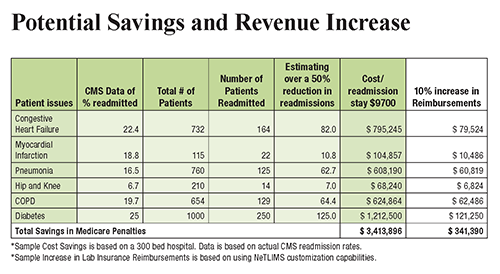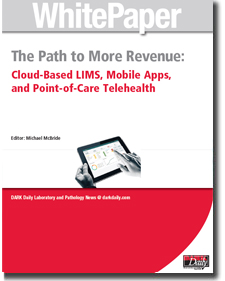EHR Sales Reached $31.5 Billion in 2018 Despite Concerns over Usability, Interoperability, and Ties to Medical Errors
Cerner and Epic are the industry’s revenue leaders, though smaller vendors remain popular with physician groupsSales of electronic health record (EHR) systems and related hardware and services reached $31.5 billion in 2018. And those sales will increase, according to a 2019 market analysis from Kalorama Information. This is important information for clinical laboratories and anatomic pathology groups that must interface with the EHRs of their physician clients to enable electronic transmission of lab orders and test results between doctor and lab.
The Kalorama report, titled, “EMR 2019: The Market for Electronic Medical Records,” ranks EHR companies based on revenue rather than market penetration. Kansas City-based Cerner holds the No.1 spot on the list. That may be due to Cerner’s securing one of the largest IT contracts in the federal government—a potential $10 billion deal over 10 years with the U.S. Department of Veterans Affairs (VA) to replace the VA’s VistA medical record system.
Is Bigger Better?
Kalorama’s ranking includes familiar big EHR manufacturer names—Cerner (NASDAQ:CERN) and Epic—and includes a new name, Change Healthcare, which was born out of Change Healthcare Holding’s merger with McKesson. However, smaller EHR vendors remain popular with many independent physicians.
“We estimate that 40% of the market is not in the top 15 [in total revenue rankings],” said Bruce Carlson, Kalorama’s publisher, in an exclusive interview with Dark Daily. “There’s a lot of room. There are small vendors out there—Amazing Charts, e-MDs, Greenway, NextGen, Athena Health—that show up on a lot of physician surveys.”

Interoperability a Key Challenge, as Most Medical Laboratories Know
Interoperability—or the lack thereof—remains one of the industry’s biggest challenges. For pathologists, that means seamless electronic communication between medical laboratories and provider hospitals can be elusive and can create a backlash against EHR vendors.
Kalorama notes a joint investigation by Fortune and Kaiser Health News (KHN), titled, “Death by a Thousand Clicks: Where Electronic Health Records Went Wrong.” The report details the growing number of medical errors tied to EHRs. One instance involved a California lawyer with herpes encephalitis who allegedly suffered irreversible brain damage due to a treatment delay caused by the failure of a critical lab test order to reach the hospital laboratory. The order was typed into the EHR, but the hospital’s software did not fully interface with the clinical laboratory’s software, so the lab did not receive the order.
“Many software vendors and LIS systems were in use prior to the real launching of EHRs—the [federal government] stimulus programs,” Carlson told Dark Daily. “There are a lot of legacy systems that aren’t compatible and don’t feed right into the EHR. It’s a work in progress.”
Though true interoperability isn’t on the immediate horizon, Carlson expects its arrival within the next five years as the U.S. Department of Health and Human Services ramps up pressure on vendors.
“I think it is going to be a simple matter eventually,” he said. “There’s going to be much more pressure from the federal government on this. They want patients to have access to their medical records. They want one record. That’s not going to happen without interoperability.”
Other common criticisms of EHRs include:
- Wasted provider time: a recent study published in JAMA Internal Medicine notes providers now spend more time in indirect patient care than interacting with patients.
- Physician burnout: EHRs have been shown to increase physician stress and burnout.
- Not worth the trouble: The debate continues over whether EHRs are improving the quality of care.
- Negative patient outcomes: Fortune’s investigation outlines patient safety risks tied to software glitches, user errors, or other flaws.
There’s No Going Back
Regardless of the challenges—and potential dangers—it appears EHRs are here to stay. “Any vendor resistance of a spirited nature is gone. Everyone is part of the CommonWell Health Alliance now,” noted Carlson.
Clinical laboratories and pathology groups should expect hospitals and health networks to continue moving forward with expansion of their EHRs and LIS integrations.
“Despite the intensity of attacks on EHRs, very few health systems are going back to paper,” Carlson said in a news release. “Hospital EHR systems are largely in place, and upgrades, consulting, and vendor switches will fuel the market.”
Thus, it behooves clinical laboratory managers and stakeholders to anticipate increased demand for interfaces to hospital-based healthcare providers, and even off-site medical settings, such as urgent care centers and retail health clinics.
—Andrea Downing Peck
Related Information:
EMR Market Tops $30 Billion, Despite Intensifying Criticism and Challenges
VA-Cerner $10B EHR Control Finally Gets Signed
McKesson and Change Healthcare Announce New Company Will be Named Change Healthcare





